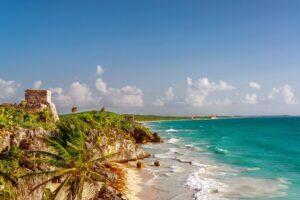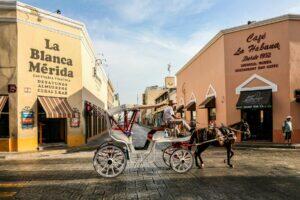Fodor's Expert Review Reserva de la Biósfera Calakmul
Encompassing some 1.8 million acres of land along the Guatemalan border, Calakmul was declared a protected biosphere reserve in 1989 and is the largest reserve of its kind in Mexico (Sian Ka'an in Quintana Roo is second with 1.3 million acres). All kinds of flora and fauna thrive here, including wildcats, spider and howler monkeys, hundreds of exotic birds, orchid varieties, butterflies, and reptiles. (There's no shortage of insects, either, so don't forget the bug repellent.)
The centerpiece of the reserve, however, is the ruined Mayan city that shares the name Calakmul (which translates as "two adjacent towers"). Although Carretera 186 runs right through the reserve, you'll need to drive about 1½ hours from the highway along a 60-km (37-mile) authorized entry road to get to the site. Structures here are still being excavated, but fortunately the dense surrounding jungle is being left in its natural state: as you walk among the ruined palaces and tumbled stelae, you'll hear the... READ MORE
Encompassing some 1.8 million acres of land along the Guatemalan border, Calakmul was declared a protected biosphere reserve in 1989 and is the largest reserve of its kind in Mexico (Sian Ka'an in Quintana Roo is second with 1.3 million acres). All kinds of flora and fauna thrive here, including wildcats, spider and howler monkeys, hundreds of exotic birds, orchid varieties, butterflies, and reptiles. (There's no shortage of insects, either, so don't forget the bug repellent.)
The centerpiece of the reserve, however, is the ruined Mayan city that shares the name Calakmul (which translates as "two adjacent towers"). Although Carretera 186 runs right through the reserve, you'll need to drive about 1½ hours from the highway along a 60-km (37-mile) authorized entry road to get to the site. Structures here are still being excavated, but fortunately the dense surrounding jungle is being left in its natural state: as you walk among the ruined palaces and tumbled stelae, you'll hear the guttural calls of howler monkeys, and see massive strangler figs enveloping equally massive trees.
This magnificent city, now in ruins, wasn't always so lonely. Anthropologists estimate that in its heyday (between AD 542 and 695) the region was inhabited by more than 50,000 Maya. Archaeologists have mapped more than 6,800 structures and found 180 stelae. Perhaps the most monumental discovery thus far has been the remains of royal ruler Gran Garra de Jaguar (Great Jaguar Claw). His body was wrapped (but not embalmed) in a shroud of palm leaf, lime, and fine cloth, and locked away in a royal tomb in about AD 700. In an adjacent crypt, a young woman wearing fine jewelry and an elaborately painted wood-and-stucco headdress was entombed together with a child. Their identity remains a mystery. The artifacts and skeletal remains have been moved to the Museo de la Arqueología Maya in Campeche City.
Unlike those at Chichén Itzá (which also peaked in importance during the classic era) the pyramids and palaces throughout Calakmul can be climbed to achieve soaring vistas. You can choose to explore the site along a short, medium, or long path, but all three eventually lead to magnificent Templo II and Templo VII —twin pyramids separated by an immense plaza. Templo II, at 175 feet, is the peninsula's tallest Mayan building. Scientists are studying a huge, intact stucco frieze deep within this structure, so it's not currently open to visitors.
Arrangements for an English-speaking tour guide should be made beforehand with Servidores Turísticos Calakmul, Río Bec Dreams, or through Chicanná Ecovillage near Xpujil. Camping is permitted at Km 6 with the Servidores Turistícos Calakmul after paying caretakers at the entrance gate. You can set up camp near the second checkpoint. Even if day-tripping, though, you'll need to bring your own food and water, as the only place to buy a snack is near the second entrance inside the museum.
You effectively pay three entrance fees; MX$42 per person and MX$70 per vehicle to the owners of the first 20 km (12½ miles) which is private land, MX$70 per person to enter the reserve at the second gate located at the museum, and another $M70 per person at the entrance to the ruins.
READ LESS





